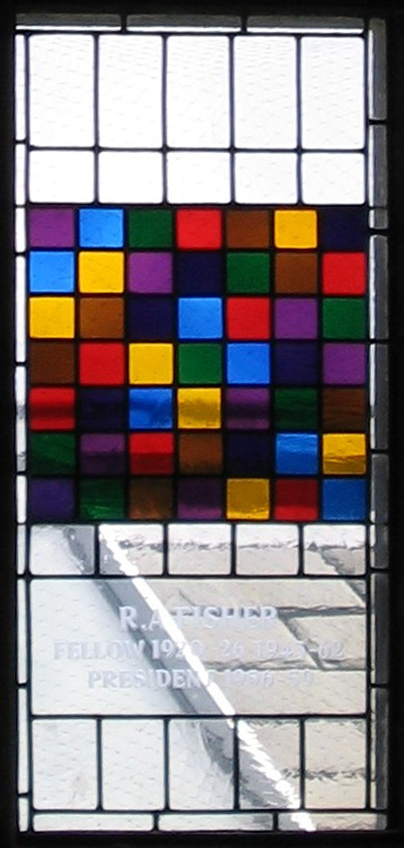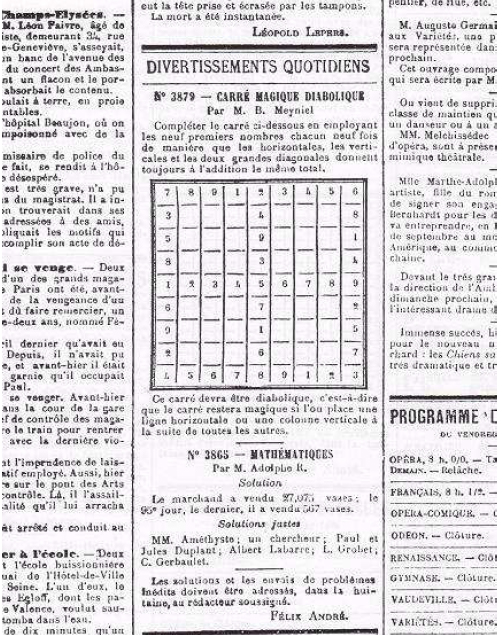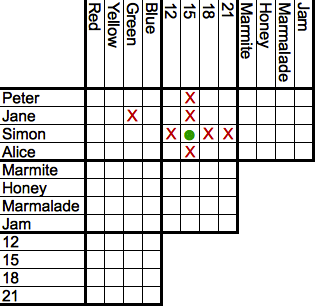|
KenKen
KenKen and KenDoku are trademarked names for a style of arithmetic and logic puzzle invented in 2004 by Japanese math teacher Tetsuya Miyamoto,A New Puzzle Challenges Math Skills '''', February 8, 2009 who intended the puzzles to be an instruction-free method of training the brain.Tetsuya Miyamoto creates KenKen. Train your brain '' |
Tetsuya Miyamoto
is a Japanese mathematics teacher who invented the numerical logic puzzle KenKen. (It is called ''Kashikoku-Naru-Puzzle'' in Japanese, which literally means "a puzzle that makes you smarter." It is also known as ''Keisan Block''.) Miyamoto developed KenKen in 2003 to help his students improve their calculation skills, logical thinking and patience. His puzzle series has sold over 1.5 million copies in Japan. It was introduced to the rest of the world at the 2007 Bologna Book Fair as KenKen and has been translated into Korean, Thai, German, French, Czech, Mandarin Chinese, Simplified Chinese, Slovene, Spanish, Portuguese, and Icelandic. KenKen made its debut in ''The Times'' (London) in March 2008, and the ''New York Times'' in February 2009. The first U.S. KenKen tournament was held in March 2009 in Brooklyn, with Miyamoto in attendance. Miyamoto graduated from Waseda University in Tokyo. He worked as an instructor at a ''juku'' (university preparatory cramming school) in Yo ... [...More Info...] [...Related Items...] OR: [Wikipedia] [Google] [Baidu] |
Latin Square
In combinatorics and in experimental design, a Latin square is an ''n'' × ''n'' array filled with ''n'' different symbols, each occurring exactly once in each row and exactly once in each column. An example of a 3×3 Latin square is The name "Latin square" was inspired by mathematical papers by Leonhard Euler (1707–1783), who used Latin characters as symbols, but any set of symbols can be used: in the above example, the alphabetic sequence A, B, C can be replaced by the integer sequence 1, 2, 3. Euler began the general theory of Latin squares. History The Korean mathematician Choi Seok-jeong was the first to publish an example of Latin squares of order nine, in order to construct a magic square in 1700, predating Leonhard Euler by 67 years. Reduced form A Latin square is said to be ''reduced'' (also, ''normalized'' or ''in standard form'') if both its first row and its first column are in their natural order. For example, the ... [...More Info...] [...Related Items...] OR: [Wikipedia] [Google] [Baidu] |
Sudoku
Sudoku (; ja, 数独, sūdoku, digit-single; originally called Number Place) is a logic-based, combinatorics, combinatorial number-placement puzzle. In classic Sudoku, the objective is to fill a 9 × 9 grid with digits so that each column, each row, and each of the nine 3 × 3 subgrids that compose the grid (also called "boxes", "blocks", or "regions") contain all of the digits from 1 to 9. The puzzle setter provides a partially completed grid, which for a well-posed puzzle has a single solution. French newspapers featured variations of the Sudoku puzzles in the 19th century, and the puzzle has appeared since 1979 in puzzle books under the name Number Place. However, the modern Sudoku only began to gain widespread popularity in 1986 when it was published by the Japanese puzzle company Nikoli (publisher), Nikoli under the name Sudoku, meaning "single number". It first appeared in a U.S. newspaper, and then ''The Times'' (London), in 2004, thanks to the efforts ... [...More Info...] [...Related Items...] OR: [Wikipedia] [Google] [Baidu] |
Will Shortz
William F. Shortz (born August 26, 1952) is an American puzzle creator and editor and crossword puzzle editor for ''The New York Times''. Early life and education Will Shortz was born and raised on an Arabian horse farm in Crawfordsville, Indiana. He was drawn to puzzles at an early age; in eighth grade he wrote a paper titled “Puzzles as a Profession.” (The paper earned him a B+.) At age 13, Shortz wrote to '' Language on Vacation'' author Dmitri Borgmann for advice on how to pursue a career in puzzles. At age 16, Shortz began regularly contributing crossword puzzles to Dell publications. He eventually graduated from Indiana University in 1974, and is the only person known to hold a college degree in enigmatology, the study of puzzles. Shortz wrote his thesis about the history of American word puzzles. Shortz achieved this by designing his own curriculum through Indiana University's Individualized Major Program. He also earned a Juris Doctor degree from the University of ... [...More Info...] [...Related Items...] OR: [Wikipedia] [Google] [Baidu] |
Inshi No Heya
{{Italic title, reason= :Japanese words and phrases ''Inshi no heya'' ( 因子の部屋 ; lit. "factoring rooms") is a type of logic puzzle published by Nikoli. It is a specific form of the KenKen puzzle genre where every operation is implied to be multiplication. Rules ''Inshi no heya'' is played on a square grid, broken into "rooms" by heavier borders. One of every room's dimensions will be a single cell; the length or width of the room varying by room. Each room may run either horizontally or vertically, and has a small number appearing in its upper left corner. The puzzle starts with all the cells empty. The goal is to fill all the cells with nonzero single-digit numbers (1 through n, where n is the length of the grid's edge) such that: *The numbers in each room, when multiplied together, equal the small number in the upper left corner of the room * No number appears twice in a column or row Solution methods A usual place to start are single-celled boxes, as these ... [...More Info...] [...Related Items...] OR: [Wikipedia] [Google] [Baidu] |
Logic Puzzle
A logic puzzle is a puzzle deriving from the mathematical field of deduction. History The logic puzzle was first produced by Charles Lutwidge Dodgson, who is better known under his pen name Lewis Carroll, the author of ''Alice's Adventures in Wonderland''. In his book ''The Game of Logic'' he introduced a game to solve problems such as confirming the conclusion "Some greyhounds are not fat" from the statements "No fat creatures run well" and "Some greyhounds run well". Puzzles like this, where we are given a list of premises and asked what can be deduced from them, are known as syllogisms. Dodgson goes on to construct much more complex puzzles consisting of up to 8 premises. In the second half of the 20th century mathematician Raymond M. Smullyan continued and expanded the branch of logic puzzles with books such as '' The Lady or the Tiger?'', '' To Mock a Mockingbird'' and ''Alice in Puzzle-Land''. He popularized the " knights and knaves" puzzles, which involve knights, who al ... [...More Info...] [...Related Items...] OR: [Wikipedia] [Google] [Baidu] |
Logic Puzzles
A logic puzzle is a puzzle deriving from the mathematical field of deduction. History The logic puzzle was first produced by Charles Lutwidge Dodgson, who is better known under his pen name Lewis Carroll, the author of ''Alice's Adventures in Wonderland''. In his book ''The Game of Logic'' he introduced a game to solve problems such as confirming the conclusion "Some greyhounds are not fat" from the statements "No fat creatures run well" and "Some greyhounds run well". Puzzles like this, where we are given a list of premises and asked what can be deduced from them, are known as syllogisms. Dodgson goes on to construct much more complex puzzles consisting of up to 8 premises. In the second half of the 20th century mathematician Raymond M. Smullyan continued and expanded the branch of logic puzzles with books such as '' The Lady or the Tiger?'', '' To Mock a Mockingbird'' and ''Alice in Puzzle-Land''. He popularized the " knights and knaves" puzzles, which involve knights, who al ... [...More Info...] [...Related Items...] OR: [Wikipedia] [Google] [Baidu] |
The College Mathematics Journal
The ''College Mathematics Journal'' is an expository magazine aimed at teachers of college mathematics, particular those teaching the first two years. It is published by Taylor & Francis on behalf of the Mathematical Association of America and is a continuation of ''Two-Year College Mathematics Journal''. It covers all aspects of mathematics. It publishes articles intended to enhance undergraduate instruction and classroom learning, including expository articles, short notes, problems, and "mathematical ephemera" such as fallacious proofs, quotations, cartoons, poetry, and humor. Paid circulation in 2008 was 9,000 and total circulation was 9,500. The MAA gives the George Pólya Awards annually "for articles of expository excellence" published in the ''College Mathematics Journal''. References External links *''The College Mathematics Journal''at JSTOR''The College Mathematics Journal''at Taylor & Francis Taylor & Francis Group is an international company originating ... [...More Info...] [...Related Items...] OR: [Wikipedia] [Google] [Baidu] |
Time (magazine)
''Time'' (stylized in all caps) is an American news magazine based in New York City. For nearly a century, it was published Weekly newspaper, weekly, but starting in March 2020 it transitioned to every other week. It was first published in New York City on March 3, 1923, and for many years it was run by its influential co-founder, Henry Luce. A European edition (''Time Europe'', formerly known as ''Time Atlantic'') is published in London and also covers the Middle East, Africa, and, since 2003, Latin America. An Asian edition (''Time Asia'') is based in Hong Kong. The South Pacific edition, which covers Australia, New Zealand, and the Pacific Islands, is based in Sydney. Since 2018, ''Time'' has been published by Time USA, LLC, owned by Marc Benioff, who acquired it from Meredith Corporation. History ''Time'' has been based in New York City since its first issue published on March 3, 1923, by Briton Hadden and Henry Luce. It was the first weekly news magazine in the United St ... [...More Info...] [...Related Items...] OR: [Wikipedia] [Google] [Baidu] |
Scholastic Corporation
Scholastic Corporation () is an American multinational publishing, education, and media company that publishes and distributes books, comics, and educational materials for schools, parents, and children. Products are distributed via retail and online sales and through schools via reading clubs and book fairs. Clifford the Big Red Dog, a character created by Norman Bridwell in 1963, serves as the company's official mascot. History Scholastic was founded in 1920 by Maurice R. Robinson near Pittsburgh, Pennsylvania, to be a publisher of youth magazines. The first publication was ''The Western Pennsylvania Scholastic''. It covered high school sports and social activities; the four-page magazine debuted on October 22, 1920, and was distributed in 50 high schools. In the 1940s, Scholastic entered the book club business. In the 1960s, international publishing locations were added in England (1964), New Zealand (1964), and Sydney (1968). Also in the 1960s, Scholastic entered the boo ... [...More Info...] [...Related Items...] OR: [Wikipedia] [Google] [Baidu] |
National Council Of Teachers Of Mathematics
Founded in 1920, The National Council of Teachers of Mathematics (NCTM) is a professional organization for schoolteachers of mathematics in the United States. One of its goals is to improve the standards of mathematics in education. NCTM holds annual national and regional conferences for teachers and publishes five journals. Journals NCTM publishes five official journals. All are available in print and online versions. ''Teaching Children Mathematics'' supports improvement of pre-K–6 mathematics education by serving as a resource for teachers so as to provide more and better mathematics for all students. It is a forum for the exchange of mathematics idea, activities, and pedagogical strategies, and or sharing and interpreting research. ''Mathematics Teaching in the Middle School'' supports the improvement of grade 5–9 mathematics education by serving as a resource for practicing and prospective teachers, as well as supervisors and teacher educators. It is a forum for the e ... [...More Info...] [...Related Items...] OR: [Wikipedia] [Google] [Baidu] |






